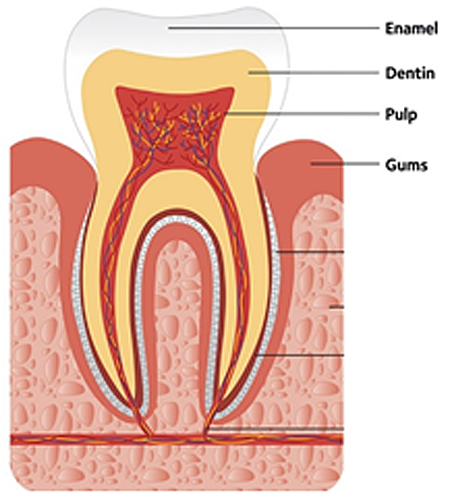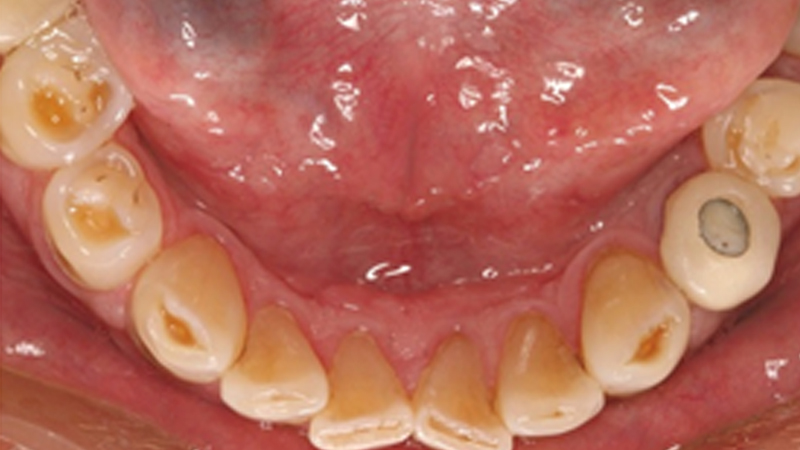What Is Acid Erosion?
The foods we eat can have a big impact on our teeth and acidic foods are no different.
Acid, most commonly from our food but also stomach acid, can erode the enamel on our teeth.
The enamel is the hard white outside layer of the tooth which protects it. Continued acid erosion can expose the next layer of the tooth, the dentine, this layer is yellow in colour and has microscopic tubule connected to the nerve (pulp) of the tooth.
When the dentine layer is exposed, the tooth can become sensitive to hot and cold causing tooth pain and trouble with eating.

Erosion doesn’t happy overnight, it occurs over 2 stages:
- Erosion: Acids on teeth remove minerals on the surface of the tooth. This causes the outside tooth surface to become softened.
- Wear: The softened and weakened tooth surfaces are worn away by things such as brushing or grinding.
Common Sources Of Acid
- Soft drinks or energy drinks (including sugar-free)
- Citrus fruits (lemons, limes, oranges)
- Kombucha
- Lemon flavoured drinks or teas
- Fruit juices or cordials
- Vitamin/soda water
- Vitamin C tablets (chewable)
- Vinegar
- Alcoholic drinks
- Stomach acid: Reflux or vomiting (e.g. morning sickness)
- Food additives: Food acids 330 (citric acid), 331 (sodium citrate), and 338 (phosphoric acid)
How To Prevent Acid Erosion
- If you are experiencing reflex or excessive vomiting, speak to your GP on possible causes and management.
- If you have noticed that you are grinding speak to your dentist as this dramatically increases the impact of acid on your teeth.
- Do NOT brush your teeth straight after vomiting but rather rinse with water and mouth wash. I know… you want to get that horrible taste out of your mouth but brushing after acid exposer damages your teeth.
- Wait at least 30 minutes to an hour after consuming acids to brush your teeth. This gives your saliva time to remineralise your teeth so they aren’t soft and vulnerable to being worn away.
- Use a soft toothbrush with fluoride and don’t rinse after brushing. This allows the fluoride to stay on the teeth and remineralise them.
- Drink water after eating to help neutralise the acid. This is also great for reducing decay.
- Consider adding a CPP-ACP to your dental routine. At iDental Surgery, we recommend and use GC Tooth Mousse Plus, an Australian invention which can help to remineralise your teeth.
Consequences Of Tooth Erosion
Over time, as the dentine layer is exposed, the teeth will appear more yellow in colour and shorter.
They will also become sensitive to hot and cold.
The tooth will become more prone to cracking and decay as the dentine layer isn’t as strong as enamel.

How Your Dentist Can Help
The main job of a dentist is to education on good oral hygiene practice and prevent conditions from getting worse. If a dentist notices the beginnings of acid erosion, they may investigate possible causes and discuss changes to prevent further damage. If the erosion is advance, a filling or crown might be needed to protect the tooth and act as a substitute enamel layer for the tooth.
To find out more call iDental Surgery today on (02) 9557 7775 or click here to book online.
Sources:
https://www.betterhealth.vic.gov.au/health/conditionsandtreatments/dental-erosion
https://www.teeth.org.au/tooth-erosion
https://www.healthdirect.gov.au/dental-erosion#:~:text=Dental%20erosion%20occurs%20when%20acids,is%20different%20to%20tooth%20decay
Image 1: Noble, W. H., & Faller, R. V. (2018). Protection from dental erosion: All fluorides are not equal. Compendium, 39(3).
